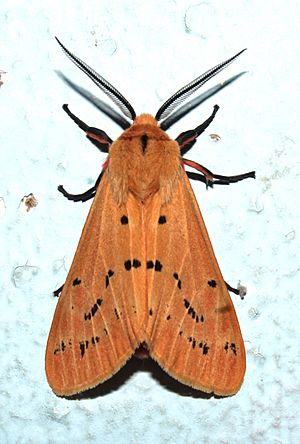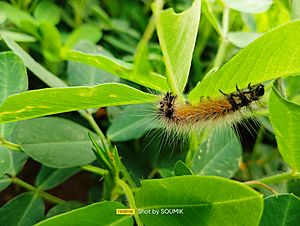Jute hairy caterpillar facts for kids
Quick facts for kids Jute hairy caterpillar |
|
|---|---|
 |
|
| Moth | |
 |
|
| Caterpillar | |
| Scientific classification | |
| Synonyms | |
|
The jute hairy caterpillar, also known as the Bihar hairy caterpillar, is a type of moth. Its scientific name is Spilosoma obliqua. This moth belongs to the Erebidae family.
You can find this moth in several countries. These include south-eastern Afghanistan, northern Pakistan, India, Bhutan, Bangladesh, and Myanmar.
Contents
What Does It Look Like?
The caterpillar of this moth has a black head. It also has tufts of black hairs right behind its head. The rest of its body is covered in similar tufts of yellow hairs.
The adult moth is quite small. Its wingspan is about 23 millimeters (about 1 inch) wide. The wings are a light brown color. They have a pattern of small black spots. The moth's body, called the abdomen, is red.
What Do They Eat?
The jute hairy caterpillar is a very hungry insect. It is known as polyphagous. This means it can eat many different kinds of plants. It feeds on at least 126 plant species!
These plants include many common crops. For example, they eat pulses, cereals, and vegetables. They also like oilseeds, mulberry, and turmeric. Important fiber crops like jute, roselle, ramie, and sunn hemp are also on their menu. They even eat wild plants and weeds.
In India, these caterpillars are a big problem for fiber crops. Sometimes, there are so many of them that it becomes an epidemic. Jute plants are especially affected. They can lose up to 30% of their yield. Nalta jute is more easily damaged than white jute.
Life Cycle and Natural Enemies
Each female moth can lay many eggs. She lays up to 1000 eggs in several groups. She places these eggs on the underside of plant leaves.
When the eggs hatch, tiny caterpillars appear. At first, they just scrape the bottom surface of the leaves. As they grow bigger, they start eating the edges of the leaves. This makes the leaves look like a net. If there are too many caterpillars, they can eat all the leaves off a plant. This is called defoliation.
These caterpillars have some natural enemies. One important enemy in India is a tiny braconid wasp called Protapanteles obliquae. This wasp helps control the caterpillar population.
The wasp lays its eggs inside the very young caterpillars. When the wasp larvae grow, they push their way out of the caterpillar's belly. They then form small, white, woolly cocoons. By this time, the caterpillar is usually dead or dying.
How Are They Controlled?
For a long time, people used special sprays called synthetic insecticides to control these pests. However, this method did not work very well. The caterpillars started to become resistant to the sprays. Also, these sprays could harm the environment.
There are natural enemies, like the wasp mentioned above. But sometimes, there are not enough natural enemies to keep the caterpillars fully under control.
Scientists are now looking into new ways to control them. One promising method uses a special virus. This virus is called SpobNPV. In tests on jute plants, spraying this virus helped a lot. It reduced the number of caterpillars by 69% after 3 days. After 7 days, the caterpillar population was reduced by 93%. This shows a safer way to protect crops.
Images for kids




